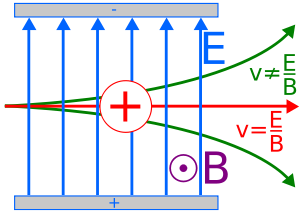
Velocity selector
Encyclopedia

Accelerator mass spectrometry
Accelerator mass spectrometry differs from other forms of mass spectrometry in that it accelerates ions to extraordinarily high kinetic energies before mass analysis. The special strength of AMS among the mass spectrometric methods is its power to separate a rare isotope from an abundant...
to select particles based on their speed. The velocity selector is composed of orthogonal electric and magnetic fields, such that particles with the correct charge to mass ratio and speed will be unaffected, and other particles will be deflected.
Theory
Any charged particle in an electric field will feel a force proportional to the charge and field strength such that , where F is force, q is charge, and E is electric field. Similarly, any particle moving in a magnetic field will feel a force proportional to the velocity and charge of the particle. The force felt by any particle is then equal to
, where F is force, q is charge, and E is electric field. Similarly, any particle moving in a magnetic field will feel a force proportional to the velocity and charge of the particle. The force felt by any particle is then equal to  , where F is force, q is the charge on the particle, v is the velocity of the particle, B is the strength of the magnetic field, and
, where F is force, q is the charge on the particle, v is the velocity of the particle, B is the strength of the magnetic field, and  is the cross product
is the cross productCross product
In mathematics, the cross product, vector product, or Gibbs vector product is a binary operation on two vectors in three-dimensional space. It results in a vector which is perpendicular to both of the vectors being multiplied and normal to the plane containing them...
. In the case of a velocity selector, the magnetic field is always at 90 degrees to the velocity and the force is simplified to
 in the direction described by the cross product.
in the direction described by the cross product.Setting the two forces to equal magnitude in opposite directions it can be shown that
 . Which means that any combination of electric (
. Which means that any combination of electric ( ) and magnetic (
) and magnetic ( ) fields will allow charged particles with only velocity
) fields will allow charged particles with only velocity  through.
through.

